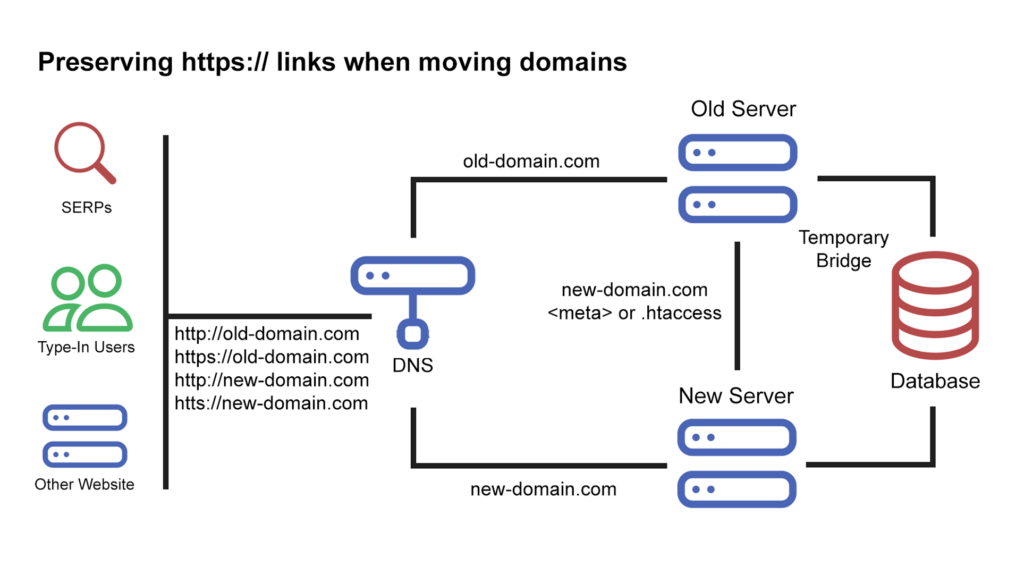Moving your website to a new domain is a lot like moving into a new home. Imagine your business transitioning from a small startup office to a corporate high-rise.
The process can be exciting and elevate your branding, but if not executed properly, it can lead to confusion and broken links across the web, leaving your customers in the dark and potentially harming your search rankings.
Redirect or Mirror? Consider Longevity
Your redirection strategy hinges on several factors:
1. Protocol – The type of protocol used (HTTP or HTTPS) affects how redirects are handled.
2. Website Size – The size and complexity of your website impact the redirection process and the resources required.
3. Backlink Profile – Analyzing your backlink profile helps determine the extent of redirection needed to maintain link equity and SEO performance.
4. Coding ability – Your proficiency in coding influences whether you can implement advanced redirection techniques and troubleshoot any issues effectively.
With DNS records, links containing “https://” will not resolve with a simple redirect; this method only functions at the “http://” level. If there isn’t a server to respond to the request, the browser will time out, leaving users stranded.
Manually updating links takes time
Search engines regularly crawl websites for updates. It may take a while for the bots to pick up on your changes. Other websites linking to you will not know about the change unless you reach out to them.
Social Media
If you have a large social media presence spread out across multiple platforms, it can take several hours for you to manually update all of your necessary profiles to ensure users are directed to the right place.
If you have thousands of “https://” links spread across your social media posts and search result pages, users will not be directed to your hosted content without the proper redirects in place. Redirects help website servers recognize the change automatically.
DNS Redirects
Before the web transitioned to secure connections with “https://,” redirecting users to your new website at the DNS level was straightforward. Employing a wildcard URL redirect could route all traffic to your new domain homepage.
As websites and the internet evolve, so does the method of directing users to new domains. You cannot redirect HTTP to HTTPS at the DNS level. This is a configuration task reserved for your web server, as it manages the protocol.
A Better Way: Creating a Mirror Site
One solution to migrating your domain is to initially construct a new site on your virtual server, utilizing a shared database between them. This process is akin to moving into a new house before selling your old one or constructing a new office while maintaining operations in the existing one.
By maintaining a presence at both locations, once the new site is fully functional, you can unveil it and establish a redirection structure on your old site. This preserves your “https://” link equity across the web and seamlessly redirects users to your new site.

Mirroring Preserves Your Existing Server
Minimal changes are made at the server level to redirect users, and the hosted files remain untouched. Reverting to the old setup can be easily accomplished.
When reverting, it’s beneficial to do so before search engines detect the changes. Frequent switching between setups could confuse search engines and potentially lead to a drop in rankings.
How to Setup Your Domain Redirects
Take great care and time in planning your domain strategy. When you are absolutely certain you are ready to move, begin directing users to your new location using one of the following methods:
Method 1: Using <meta refresh>
If you have a very small website (such as a one-pager) or lack programming abilities, adding a simple meta refresh to your most important pages will suffice to direct your visitors. However, ensure to include a manual link on the page in case the redirection doesn’t occur automatically.
<meta http-equiv="refresh" content="0; url=YOUR_NEW_URL" />
<a href="YOUR_NEW_URL">Click here if not directed automatically</a>
Method 2: Using .htaccess
This is the preferred method for larger dynamic websites. You can create a series of redirects based on your website structure to maintain search engine links, or you can redirect all requests back to the index page.
RewriteEngine On
RewriteCond %{HTTP_HOST} ^olddomain\.com$ [NC]
RewriteRule ^(.*)$ http://newdomain.com/$1 [R=301,L]
Bottom Line
Transitioning your website to a new domain is akin to an office moving to a new physical location—it can elevate your brand but requires careful planning to avoid pitfalls. Consider factors such as protocol, website size, backlink profile, and your coding ability when deciding on a redirection strategy.
Manual link updates can be time-consuming, and DNS redirects have limitations, necessitating alternative methods like creating a mirror site. Take care in implementing a redirect structure, whether through <meta refresh> or .htaccess, to ensure a smooth transition for users and maintain your search engine rankings.
Ultimately, hosting your new domain separately provides flexibility, making it easier to switch back if needed. By meticulously planning and executing your domain transition, you can reap the benefits of a refreshed online presence while minimizing disruptions to your audience and search engine visibility.
